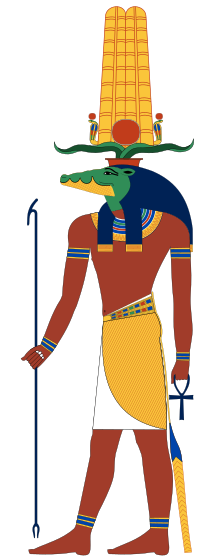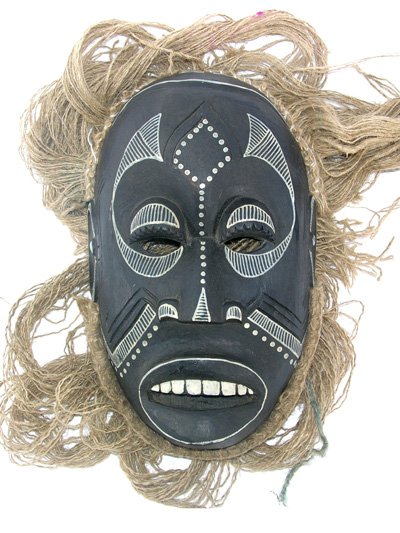 What is Sobekianism?
What is Sobekianism?Sobekianism is a religion dedicated to the worship of the crocodile god Sobek and other gods of Kemetic (Ancient Egyptian) origin. It is not a reconstructed Kemetic religion. Sobekianism is a modern belief system with a strong emphasis on eclecticism.
Who is Sobek?Sobek (also known as Sebek, Suchos and Sobek-Ra) is the Crocodile God, Lord of The Waters and the supreme patron god in Sobekianism. Sobek is the benevolent god of crocodiles, water, power and fertility. He also represents the primordial forces in nature that shape the world.
Which other deities are honored in Sobekianism?Although all deities can be worshipped in Sobekianism, gods and goddesses connected to Sobek are most honored. The following deities are quite notable in Sobekianism:
- Hathor: wife of Sobek, cow goddess of joy, love, fertility and fun.
- Khonsu: son of Sobek and Hathor, god of the moon, traveling and youth. Together with Sobek and Hathor, they form the Sobekian Triad.
- Nit: mother of Sobek and the wisest of the Kemetic gods. She is a warrior goddess and a matron of craftsmen.
- Amun: the past incarnation of Sobek. He was a very powerful god who mysteriously disappeared after the creation of the universe.
- Ra: father-in-law of Sobek and father of Hathor. He is the sun god in Kemetic religion. His name is of great importance in Sobekian rituals. Also known as Re.
- Horus: warrior god, god of vengeance and friend of Sobek. Also known as Heru.
- Isis: goddess of magic, mother of Heru. Sobek assisted in the birth of Heru. Also known as Aset.
- Osiris: god of the underworld, husband of Isis, father of Horus. Sobek assisted in his resurrection after being murdered by the dark god Seth. Also known as Asar.
- Renenunet: second wife of Sobek, cobra goddess of magical names and fertility. She is a powerful sorceress who’s very cunning yet very benevolent.
- Tawaret: third wife of Sobek, hippopotamus goddess of protection, pregnancy and restraining evil forces. She is a strong warrior goddess who adores mothers and children.
- The Petsuchos – They are the sacred crocodiles that serve Sobek. Worshipped in Ancient Egypt, now they have a special place in the Sobekian afterlife as guardians of the dead.
What are the basic tenets of Sobekianism?To, at least, grasp the greatness of Sobek is to emulate the positive qualities of the crocodile. The crocodile is an ancient beast, a survivor from the age of the dinosaurs. It is even considered as a living dinosaur. The crocodile is a symbol of power, primal forces, ancient knowledge, fertility and survival. Its ferocity and cunningness are qualities worth developing if used correctly. Sobek represents the crocodile in its most divine incarnation.
In Ancient Egypt, sacred crocodiles were kept in private lakes. They were adorned with jewelry and fed with cakes, bread and roasted meat. Sobek teaches that we should enjoy good food, nice things to wear and other fine things in life. In other words, eat, drink and be merry! The ideal Sobekian is a noble savage, an atavistic mage and a warrior hedonist all rolled into one.
What is the afterlife like for Sobekians? One great thing about Sobekianism is that its concept of the afterlife is radically different from the typical afterlife of the Kemetists. Instead of going through elaborate funerary rituals and facing numerous perils in the afterlife before reaching Amenti (the Egyptian heaven), worthy Sobekians are protected by the sacred crocodiles Petsuchos and led to a marvelous version of the Nile River called the Heavenly Nile.
On the shores of the Heavenly Nile, a huge and endless celebration is being held. All sorts of delicious food are being served, everyone is wearing fantastic jewelry and beautiful women (plus men) are everywhere. Music, games and dancing fill the whole riverside. Lording over everything is the crocodile god Sobek. Along with his favorite wife Hathor, he makes sure that everyone is having a great time. That is a true paradise for followers of Sobek.
What is the punishment for unworthy people in the Sobekian afterlife?If that person is deemed too unrepentantly evil to enter the Heavenly Nile, Sobek will devour that person. To avoid this terrible fate, the ever universal Golden Rule must be followed: Do to others what you’d like them to do to you. In other words, don’t be an asshole. Follow the Golden Rule and you might be worthy enough to enter the Heavenly Nile.
What are the rituals in Sobekianism?Party of the beauty of Sobekianism is its strong advocacy on eclecticism inspired by chaos magic. Sobekians are encouraged to create their own prayers and rituals to honor the Crocodile God. If they wish to, they can even make their own Sobekian spells to attract special needs. However, the most basic and fundamental practice that all Sobekians must perform daily is the chanting of the holy name SOBEK-RA. Sobek-Ra is Sobek’s most powerful form especially when empowered by the power of the sun. Chanting SOBEK-RA invokes the power of the Crocodile God and attracts his blessings. The holy name must be chanted at least three times. At the end of every prayer, the holy name must be chanted three times to further empower the prayer. Chanting SOBEK-RA is a must for the faithful Sobekian.
Is there a church or temple Sobekians can worship in?As of now, there are no temples. However, Sobekians are encouraged to meet up, worship and discuss anything related to the Crocodile God. In dire circumstances, Sobekians must band together for survival just like the ancient reptilian beasts.
Is there a priesthood in Sobekianism?
Sobekians are their own priests. They are their own pharaohs. Sobekians have no need for such antiquated authority figures to govern them. Sobekians govern themselves. However, in certain circumstances, leaders (in a more secular sense) are made to make things easier. Mentors may also be assigned to guide newer Sobekians in the ways of the croc.
Why become a Sobekian?Imagine yourself as Conan the Barbarian and Sobek is your Crom. One reason that makes Conan a great warrior and leader is his devotion to his god Crom. Sobek is like Crom but more fun and with a lot of style. You too can unlock your inner crocodile and become more awesome than ever. If you have an affinity for reptiles and Egyptian gods, Sobekianism is for you. If you immensely enjoy good food and nice clothing, Sobekianism is for you. If you’re looking for a religion fit for warriors and leaders, Sobekianism is for you. However, if you don’t feel that it’s for you, do not fret. Sobek loves you anyway. Who knows? He might even invite you to the eternal party in the Heavenly Nile.
In brightest day and blackest night,
No evil shall escape my bite.
Let all enemies be filled with fright.
Beware my power – Sobekian might!








